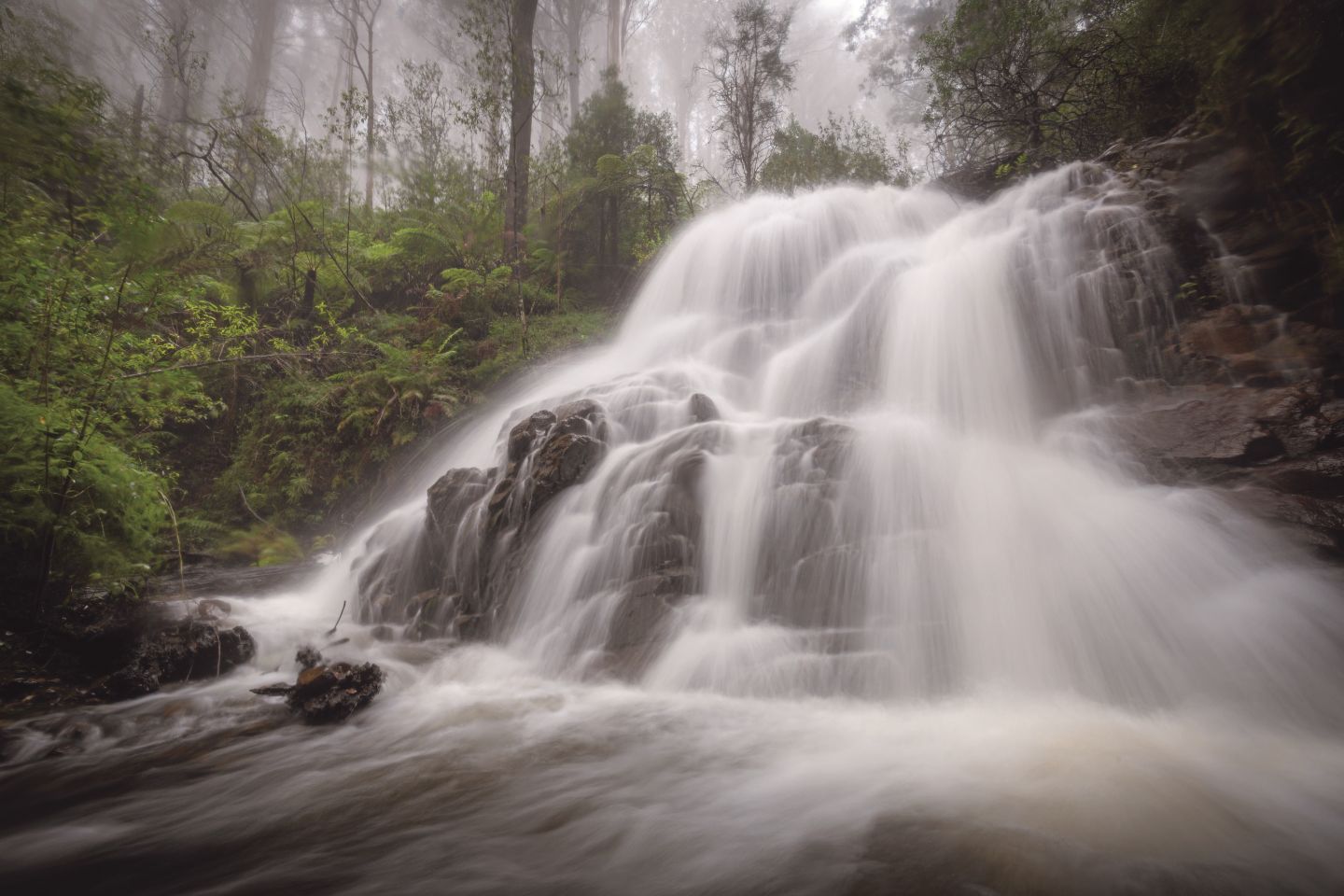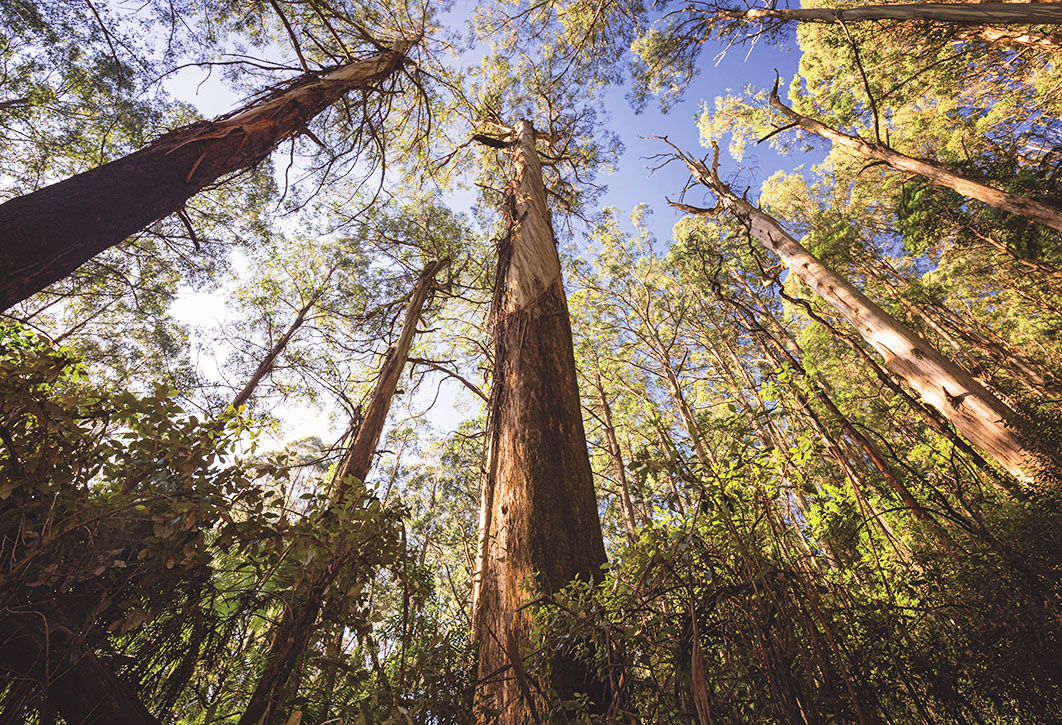The Great Forest: The Rare Beauty of the Victorian Central Highlands
By David Lindenmayer, with photographs by Chris Taylor, Sarah Rees and Steven Kuiter | Allen & Unwin | $49.99 | 192 pages
The forest is beautiful and enchanted. Walking through it you feel the damp mulch of its floor give gently beneath your feet. It is like stepping on something that is alive. Fern fronds shiver as you pass, showering remnants of the last rain. Great streamers of bark, cast-offs from the giants, lie crumpled and entangled among the hazel Pomaderris, blanketleaf and bright-green moss. Silver wattle and dark-leaved blackwood embower you. Deep in a gully, your path may be carpeted with the small glowing leaves of myrtle beech.
Suddenly you stumble upon a great presence. A massive fibrous foot rears out of the leaf litter, searching for clear air and sunshine as it rises, now pale-trunked and straight as a pole, to a distant, high canopy. This upper realm it shares only with its own kind, their heads in the mist — or is that smoke? You have met the monarch, Eucalyptus regnans, the Mountain Ash.
This remarkable forest is close to Melbourne, just an hour and a half from the MCG. It is a magical kingdom where Earth’s tallest flowering plant soars to heights approaching one hundred metres and where, at its feet, is found a ferny understorey of cascading waters and dancing lyrebirds.
This precious ecosystem on the edge of Australia’s southern metropolis is evoked and celebrated in The Great Forest. Written by distinguished forest scientist David Lindenmayer and illustrated with stunning photographs by Sarah Rees, Chris Taylor and Steven Kuiter, this new book reminds us that the towering forests of ash are both awe-inspiring and fragile. We are living through the moment when the future of this immensely old and delicate ecosystem is hanging in the balance.
As Lindenmayer says, “there is perhaps nothing more extraordinary than an old-growth Mountain Ash forest.” He lovingly describes the magical environment in which he has worked for four decades, mapping and understanding the evolution of the forest and tracking the endangered Wollert (Leadbeater’s possum), one of Victoria’s faunal emblems. In the understorey of the Great Forest you might find 10,000 different gene sequences for fungi and soft tree ferns that could be 1000 years old. And at the foot of the world’s tallest flowering plant is the world’s tallest moss (reaching fifty centimetres). Everything is straining towards the light.
Long-term ecological studies require immense personal dedication and institutional support, and deliver precious insights and great public benefit. Australians should feel deep gratitude for the work that Lindenmayer and his research team have been doing since the 1980s from his base at the Australian National University.
The Mountain Ash is not only a majestic eucalypt, it is also a distinctive one. For the first fifty years of its life it can grow a metre a year, reaching similar heights to the giant redwoods of North America but in a quarter to half the time. When mature its girth can exceed thirty metres. Old trees shed tonnes of bark every year and dangle streamers of bark designed to take fire into the canopy. The Mountain Ash is unusually dependent on its seed supply for regeneration — and it needs a firestorm to crack open those seeds high in the crowns of the trees and to cultivate the saplings successfully. Ash-type eucalypts generally grow in even-aged stands; they renew themselves en masse. These magnificent trees have evolved to commit mass suicide once every few hundred years, on the hottest, windiest days after long drought. And when they burn, they do so with atomic power — as the Black Days (Thursday, Friday, Saturday…) of Australia’s recent fire history testify.
The continent’s weather pivots dramatically here between cold Antarctic fronts and hot northerlies from the centre. What kind of organism profits from this combustible edge, growing fast on the wet, cool bounty of the Southern Ocean but drawing also on periodical incursions of fiery breath from the arid, continental inland? A magnificent tall, wet fire weed.
Since European invasion, firestorms have become more frequent. Fires are essential for regeneration of the forest, but if fire returns before the young trees have produced seed, the species can be eliminated. This fragile long-term balance has been destabilised by clearing, logging and climate change.
But Indigenous peoples in this region lived with firestorms too. Aboriginal mosaic burning, which was applied to so many drier woodlands across the continent, is sometimes wrongly assumed to have been used in the wet Mountain Ash forests too. For example, in his popular, prize-winning book Dark Emu (2014), Bruce Pascoe argued that Aboriginal peoples managed Mountain Ash forests with “a mosaic pattern of low-level burns” and that wild fires in the forests affected by Black Saturday “were largely unknown before the arrival of Europeans.” But this cannot have been the case, for ash forests would have been destroyed by frequent fires, and low-level burns are not feasible in such a wet ecosystem.
Wurundjeri, Taungurung and Gunaikurnai peoples used the tall forests seasonally and probably burned their margins, maintaining clearings and pathways along river flats and ridgetops. They were familiar with the forest’s firestorms and would have known the dangerous days.
The opportunity to walk in an old-growth Mountain Ash forest — an experience familiar and beloved to our recent forebears — is becoming a rarity. As Lindenmayer explains, old-growth forest once comprised 30–60 per cent of the Mountain Ash ecosystem, and now it makes up just 1.2 per cent. That is a horrifying statistic. The loss has been caused by industrial-scale logging and an accelerated cycle of fire. The two are inextricably related: logging operations make forests more prone to high-severity fire. And logging large old trees after a fire, so frequently done, can make the habitat unsuitable for many wildlife species for up to two centuries.
As a result of these changes and incursions, the Mountain Ash forests of Victoria’s Central Highlands are now classified as critically endangered under the International Union for Conservation of Nature. We are fast losing an ecosystem that is both precious and productive. Old-growth forests support rich biodiversity, furnish nesting hollows for animals, store large amounts of carbon and generate high water yields. The tall trees, many of them in closed catchments, milk the clouds and deliver an unusually high-quality fresh water supply to the city. Water from these forests is worth more than twenty-five times the commercial value of their timber.
The Great Forest is an exquisite book that should alert people to the majesty of this environment. Readers will delight in Chris Taylor’s photos of rock and heathland on the Baw Baw Plateau and his panoramas of the Cathedral Range (Nanadhong), Sarah Rees’s rendering of delicate montane fens and her subtle compositions of air, light and water in Wurundjeri Country, and Steven Kuiter’s gorgeous portraits of a pink robin in rainforest and a powerful owl with its (beheaded) prey. The book seductively invites you into the sensory worlds of tree canopy, granite tor, fern bower and leaf litter. I’ve walked many gullies and ridges of the Great Forest but this book revealed more glorious secrets to me.

A dawalin (the Taungurung word for waterfall) during a storm in the Toolangi Forest on Taungurung Country. Chris Taylor
The splendour of the book is reminiscent of the imagery and advocacy generated in the 1970s and 80s about the forests of southwest Tasmania. The photographs of Olegas Truchanas and Peter Dombrovskis came to define a region threatened by unbridled hydro-electric development, distilling its majesty and ecological integrity for city audiences. Their photos of wild rivers and luminous rainforest, panoramas of peak and range, and insect-eye portraits of pebble and leaf enabled people to inhabit these remote places — and to fight for them. The Great Forest is a book in that tradition. It offers beauty, science and advocacy in defence of an ecosystem under attack.
The book pays respect to Country, beginning with a Statement of Sovereignty from Lidia Thorpe, the first Aboriginal senator for Victoria, and locating photos and events in Wurundjeri, Taungurung, Gunaikurnai and Bunurong Countries. This constant education in language and territory invokes not only the deep past of this place but also its enduring ecological and cultural coherence.
Giving this vast, diverse ecosystem a single name — “The Great Forest” — is also powerful politics, making it simpler to celebrate and defend. In 2001 I chose the name Forests of Ash for my book about the same environment, a title that united ash and fire, ecology and history. But “The Great Forest” has the advantage of being both complimentary and singular. It brings back into parlance the nineteenth-century name given to the Great Forest of South Gippsland, rugged tracts of Mountain Ash country that farmers fought with axe and fire over a hundred years ago. It also ties the book to the decade-long campaign to create the Great Forest National Park, which proposes to link, extend and upgrade existing reserves to ensure better protection for the tall trees and all the life they harbour.
Both campaign and book depict the Great Forest as proximate yet unknown, as “hidden in plain sight.” We are told that the forest is on Melbourne’s doorstep but few know it is there; it remains “largely unappreciated.” This argument heightens our sense of discovery and the feeling that we are appreciating a secret just in time. Although there is clearly truth in this, it underplays two centuries of settler awe, affection and advocacy. The book understandably presents a sharp contrast between the long-term care by Aboriginal custodians and the “brutal and catastrophic” impacts of European colonisation. Scientists tend to enforce this opposition, thus simplifying the environmental sensibilities of both Indigenous and settler cultures. The newcomers compromised the natural values of ecosystems so severely that scientists often depict settlers in purely negative terms, as “disturbances.” But there is another story about this forest that might be told, one that is barely hinted at here.
Victorians have long known and loved this forest. From the beginning, it quickly became part of their identity. Colonial Victorians knew they lived among tall gum trees: residents became known as Gumsuckers as opposed to Cornstalks (New South Wales), Bananalanders (Queensland), Croweaters (South Australia) or Sandgropers (Western Australia). “Fernmania” and “wildflowering” took hold of the populace, and excursionists and picnickers made raids into the Great Forest. Naturalists and bushwalkers came to know and love every peak and gully. There were sponsored searches for the tallest trees, and Victorians boasted of their heights at intercolonial and international exhibitions. Beloved ancient giants were given names similar to those bestowed on Aboriginal individuals identified as “the last of the tribe”: “King Edward VII,” “Uncle Sam” or “Big Ben.” Pilgrimages were made to their great buttresses — an impressive photo of the entire village of Fernshaw gathered at the foot of Furmston’s Tree in 1933 is included in the book. International visitors to Melbourne were taken to see the tall trees and to hear the lyrebird; Californian conservationist John Muir had to be shown the towering rival to his celebrated redwood. Noted colonial photographers J.W. Lindt and Nicholas Caire — antecedents of The Great Forest photographers — brilliantly captured the magic of fern gullies and forest giants. Many of their images hung in railway carriages, and Lindt sold 25,000 prints of the Black Spur area alone in the 1880s.
Small-scale sawmillers felt awe for the forest even as they cut it down. Workers at bush sawmills lived in the heart of the Great Forest in small, remote communities that women and children might escape only once or twice a year. When firestorms bore down upon them, as they did increasingly with the incursions of sawmilling, these vulnerable families cowered in primitive underground dugouts. When the royal commission into the 1939 fires held hearings in forest communities, it was foresters, sawmillers and bush workers who patiently tutored Judge Leonard Stretton on the distinctive characteristics of the Mountain Ash forests. University botanists, schooled overseas, didn’t know nearly as much as the local bushmen.
It was not until the late 1940s that an ecologist began to “pry into the personal life of E. regnans,” as he put it. That was David Ashton (1927–2005), a gentle botanist, artist and poet who conducted a fifty-year experiment in the Mountain Ash forests after they were severely burnt in the Black Friday fires of 1939. He worked at Wallaby Creek in a cathedral of tall trees seeded in a great fire in the summer of 1710, a century before European arrival (he counted growth rings). The well-named Ashton discovered the essential role of intense, fast-moving crown fires in the regeneration of Mountain Ash, and revealed that the conditions that renew the tall forests are the very same ones that conjure a firestorm from hell for any humans in its path. But he also found that frequent fire was devastating to the future of the ash. Ashton is not mentioned in this book, but he was Lindenmayer’s outstanding predecessor. They are the two brilliant, dedicated ecologists of the Great Forest.
In the 1920s and 30s Mountain Ash became Victoria’s most sought-after building timber. Tramways snaked into inaccessible gullies, bringing timber to the railheads. Sawmilling destroyed the forest and accelerated the incursions of severe fire, but it was also a local, family economy with strong links to the communities of the bush.
Later in the twentieth century, multinational companies in league with government scorched and smashed the forest for export and woodchips. This was a different era of industrial-scale clear-felling. Many of the old sawmillers recognised that their industry now operated without restraint and they felt the loss. A bunch of dedicated enthusiasts set about documenting the “timber tramway” era of forest sawmilling and became ardent champions of both the natural and cultural heritage of the forests. History and natural history are not necessarily in opposition. They can come together to defend the Great Forest today.
The Mountain Ash forests are pillars of Victoria’s identity. When Melbourne opened its new museum in the Exhibition Gardens in 2000, it chose to place the Great Forest at its heart. There at the core of Melbourne Museum is the Forest Gallery, a living outdoor space focusing on the tall Mountain Ash forests of Victoria. It has trees, shrubs and ferns, live animal exhibits, flitting birds and cascading water.
The “producer” (yes, that was his title) of the Forest Gallery, Luke Simpkin, called it a “shop window” on the magnificent tall forests. During planning it was called “The Gallery of Life,” for it aimed to overturn the notion of a museum as a place of dead things extracted from drawers and cabinets. It was also envisaged as the symbolic keystone of the new institution, connecting the “science” displays to its left and the “history” exhibitions to its right, reminding visitors how knowledge comes together in place, in a whole, living environment.
The Forest Gallery is cool, refreshing and evocative. During the vaccination rollout in Victoria in the spring of 2021, the Exhibition Building vaccination hub opened an overflow centre in the museum, next to the Forest Gallery. The nurse looking after my daughter said she was delighted to have its green, watery coolness nearby: “I take my breaks in there, go for a walk, and reset.” This little city satellite of the Great Forest is doing its job.
The secret revealed by this book is not that the Great Forest exists, but that it is being lost. In the Central Highlands there has been a massive decline in the area of old growth in the past twenty-five years. The Victorian government’s decision to end native forest logging in 2030 is welcome but too late. Lindenmayer convincingly argues why it must end earlier, preferably by 2024. For a start, a decade’s supply of commercial timber just isn’t there. Furthermore, current logging in the Central Highlands is both uneconomic and destructive: it is leading to further loss of large trees and the decline of animal populations, and creating an even more fire-prone landscape. Carbon storage and water production are much more valuable to the state than exporting woodchips. Victoria would save between $110 million and $190 million annually if logging stopped today.
Logging frequently breaches the logging laws and codes that do exist. For example, three-quarters of current logging operations in the Upper Goulburn water supply catchment alone are in breach of codes of practice. In May last year the Federal Court, in a scathing judgement, found VicForests in breach of its obligations under the Central Highlands Regional Forest Agreement in no fewer than sixty-six coupes. The Great Forest ends with Chris Taylor’s photos of recent logging operations. They are not sensational but documentary, and are carefully interpreted for readers so that we understand how logging operations are breaking the law and why the long-term effects are devastating.
Challenging the forest industry requires courage, for it does not play nicely. Its corporate spokespeople smoothly dispense spin. In the southeast forests of New South Wales in the 1980s, state forestry officers permitted woodchipping of giant trees dating from the sixteenth century while blithely assuring the public that no old-growth forests were being logged. Similar deceptions have been perpetrated in Victoria.
When you take the industry on, as Lindenmayer has done with solid science and careful long-term monitoring, it sledges you. Industry lobbyists and sections of News Corp have made personal attacks on the scientist’s reputation. This year the Victorian County Court forced two timber industry advocates to retract their comments and apologise. In 2020 more than a hundred Australian and international scientists wrote to the Victorian government expressing their “shock and dismay” at the comments of Monique Dawson, CEO of Victoria’s logging agency, VicForests, who refused to accept Lindenmayer’s published opinions or acknowledge him as an authority. Corporate Australia doesn’t want to hear inconvenient truths. Meanwhile a precious ancient ecosystem crashes and burns in our lifetime.
Australia’s forest wars, like its climate wars, have been debilitating. Facts are constantly met with entrenched denial. Vested interests delay sensible, urgent action. In a world tipping into runaway biodiversity loss and climate change, we can now see clearly that the people defending old-growth native forests have been both heroic and right. I am filled with admiration and gratitude for the First Nations peoples, the scientists and activists, the photographers and artists, the historians and storytellers who know that the future of all creatures depends on the health of these forests. Many of them live close to the trees and are defending culture and community as well as ecology. A Great Forest National Park will strengthen Indigenous land management, water production, carbon capture, fire safety, biodiversity, the tourist economy and local wellbeing. The tall trees make us feel puny, but we will decide their fate. •




